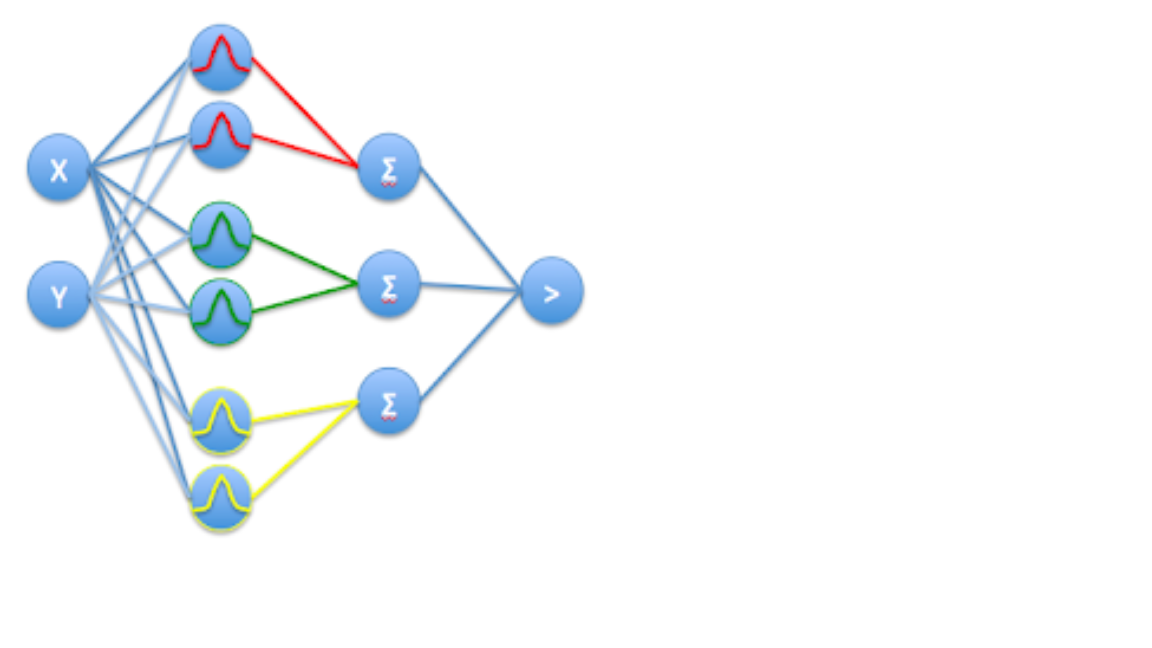Probabilistic Neural Networks

Introduction
A probabilistic neural network (PNN) is a feedforward neural network, which is widely used in classification and pattern recognition problems. In the PNN algorithm, the parent probability distribution function (PDF) of each class is approximated by a Parzen window and a non-parametric function. Then, using PDF of each class, the class probability of a new input data is estimated and Bayes’ rule is then employed to allocate the class with highest posterior probability to new input data.
By this method, the probability of mis-classification is minimized. This type of ANN was derived from the Bayesian network and a statistical algorithm called Kernel Fisher discriminant analysis. It was introduced by D.F. Specht in 1966.
In a PNN, the operations are organized into a multilayered feedforward network with four layers:
- Input layer
- Pattern layer
- Summation layer
- Output layer
# Loading Libraries
import numpy as np
import pandas as pd
import matplotlib.pyplot as plt
import matplotlib as mpl
import seaborn as sns
sns.set_style("ticks")
mpl.rcParams['axes.linewidth'] = 3
mpl.rcParams['lines.linewidth'] =7
def Create_DataFrame():
# defining the features and class labels as a dictionary
data = {
"Feature_1" : [0.1, 0.5, 0.2, 0.6, 0.8, 0.4, 0.8, 0.6, 0.3],
"Feature_2" : [0.9, 0.9, 0.7, 0.6, 0.8, 0.5, 0.5, 0.3, 0.2],
"Class_Label" : [1, 1, 1, 2, 2, 2, 3, 3, 3]
}
# converting the dictionary into a dataframe
df = pd.DataFrame(data = data)
return df
def PNN(df, DesiredPoint):
# defining a group for each class labels
Clusters = df.groupby("Class_Label")
# defining the number of classes as clusters
NumClusters = len(Clusters)
# an empty dictionary for calculating the sum of Gaussian for each class
GaussianSums = dict()
# defining the number of features
NumFeatures = df.shape[1] - 1
# defining the standard deviation for Gaussian distribution
Sigma = 1.0
# creating features array
Features = df.drop(["Class_Label"], axis = 1).values
# INPUT LAYER OF PNN
# defining a row variable for moving over the data row by row
_row = 0
# loop over the number of clusters
for i in range(1, NumClusters + 1):
# initialize the GaussianSum for each class
GaussianSums[i] = 0.0
# defining the number of points per cluster
PointsPerCluster = len(Clusters.get_group(i))
# PATTERN LAYER OF PNN
# definining temporary sum for holding the sum of X and Y elements
TempSum = 0.0
# loop over points of each cluster and GaussianSum calculation
for j in range(1, PointsPerCluster + 1):
# calculating the X element of Gauassian
TempX = ( DesiredPoint[0] - Features[_row][0] )**2
# calculating the y element of Gauassian
TempY = ( DesiredPoint[1] - Features[_row][1] )**2
# calculating the Gaussian
TempCoeff = -(TempX + TempY)/(2.0 * Sigma**2)
# adding the calculated Gaussian for all the points per cluster
TempSum += TempCoeff
# incrementing the row to cover all points per cluster
_row += 1
# storing the GaussianSum per cluster in a dictionary
GaussianSums[i] = TempSum
# returning the key of the maximum GaussianSum per cluster
CalculatedClass = max(GaussianSums, key = GaussianSums.get)
# Visualization
Visualization(df, Features, DesiredPoint, CalculatedClass)
print("Calculated Class = " + str(CalculatedClass))
def Visualization(df, Features, DesiredPoint, CalculatedClass):
color_dict = {1 : "Red", 2 : "Yellow", 3 : "Green"}
plt.figure(figsize=(10,6))
plt.scatter(Features[:,0],
Features[:,1],
s = 300.,
c = df["Class_Label"],
cmap=plt.cm.prism,
marker = "o",
lw = 3,
edgecolor='k')
plt.scatter(DesiredPoint[0],
DesiredPoint[1],
s = 300.,
c = "k",
marker = "*",
lw = 3,
edgecolor='k')
plt.xlabel("Feature 1", fontsize = 20)
plt.ylabel("Feature 2", fontsize = 20)
plt.title("Predicted Cluster = " + color_dict[CalculatedClass], fontsize = 20)
plt.xlim([0,1])
plt.ylim([0,1])
plt.show()
def main():
# desired point for clustering
DesiredPoint = [0.9, 0.1]
df = Create_DataFrame()
print("************** Dataframe ***************")
print(df)
print("****************************************")
print("Desired Point = [{}, {}]".format(DesiredPoint[0], DesiredPoint[1]))
PNN(df, DesiredPoint)
main()
************** Dataframe ***************
Class_Label Feature_1 Feature_2
0 1 0.1 0.9
1 1 0.5 0.9
2 1 0.2 0.7
3 2 0.6 0.6
4 2 0.8 0.8
5 2 0.4 0.5
6 3 0.8 0.5
7 3 0.6 0.3
8 3 0.3 0.2
****************************************
Desired Point = [0.9, 0.1]

Calculated Class = 3